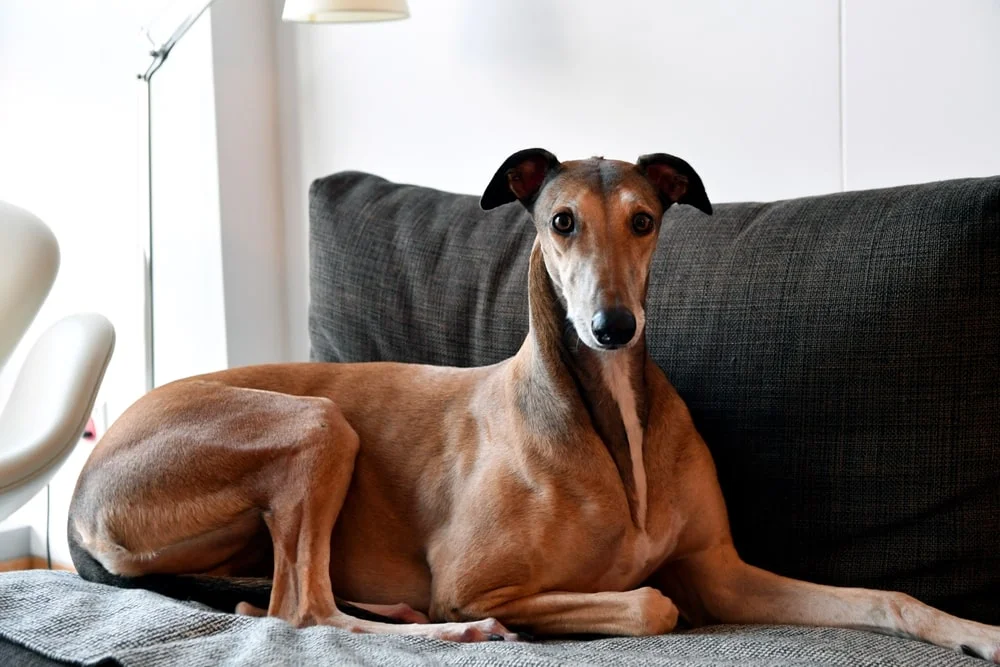BREED SPOTLIGHT
What Are Some Facts About Greyhounds?
LIFESPAN:
10 – 15 years
WEIGHT:
57 – 88 pounds
HEIGHT:
28 – 30 inches
DO I SHED?:
Yes
Personality:
Relaxed, affectionate, shy with strangers
Common Health Problems:
Bloat, von Willebrand disease, anesthesia sensitivity
Greyhound: How Do I Look?
The greyhound dog is graceful and sleek, with a short coat, deep chest, and long legs. Their stature is their most striking and distinct feature.
Coat types and colors
The greyhound dog has a short, thin, and smooth coat.1 Greyhound owners must consider their thin coat when the weather gets colder and may want to opt for a doggy sweater.
Greyhounds’ coats can come in solid colors — including brown, gray, black, and white — and they can have spots or brindle.2
Shedding and grooming
Greyhounds are only mild shedders, so they don’t have a lot of grooming needs. Regular nail trims, ear checks, and baths should suffice.3
Ears
A greyhound’s ears are small, delicate, and flop backward.2
Drooling level
Greyhounds are noble dogs and typically aren’t big droolers.3
Greyhound: Personality Traits
What My Adoption Bio Would Say:
Even though I’m the fastest dog breed, you might be surprised to learn I’m content spending most of my time on the couch with you. I love being affectionate with my family, but I can seem shy or aloof when it comes to strangers. You don’t need a sprawling farm for me — I’m just as happy in an apartment! But be sure you let me show you how fast I can run sometimes.
Behavior
The greyhound temperament loves attention but isn’t demanding. As independent and sensitive dogs, they’re content to be couch potatoes while you go about your day. Retired racing greyhounds may be especially likely to enjoy being lazy.
Greyhounds are playful and known to chase other small animals, so they must be kept in a safe, enclosed space. If they take off after something, their quickness is just one of the many fun greyhound characteristics.2
Trainability
When training, dog owners must first understand greyhound behavior to avoid frustration. Greyhounds are a coursing breed, also called sighthounds, which means they were bred to pursue game using their eyes rather than their noses. The independent spirit you notice in your greyhound’s personality is ingrained in them, so early training and socialization are key.3
Training lessons should also be brief, as greyhounds can quickly become bored. Because of their sensitive nature, training should involve gentle commands and positive reinforcement instead of harsh reprimands.3
Exercise needs
Based on most people’s perceptions of greyhounds as racing dogs, you might think they need tons of exercise. As we’ve mentioned, they’re happy to lie around most of the time, but they still need regular exercise and the chance to run at their full speed (which is an impressive sight).
Play fetch with a ball or other toy that they can chase down. Be sure to keep them leashed when not in an enclosed area, so they don’t take off after something they perceive as prey.3
Good with kids?
Greyhounds are good with children as long as they’re properly socialized at a young age. Generally, they make great family pets.3
Good with other pets?
In most cases, greyhounds get along well with other pets, especially when brought up in the same household. There might be some issues with smaller pets introduced later in life, which is why early socialization and training are recommended.4
Barking level
Greyhound mouths aren’t as fast as their feet, and by that, we simply mean they don’t bark a lot. Besides occasionally barking to let their families know someone’s at the door, they’re generally quiet dogs.3
Greyhounds: A History
Greyhounds’ history started nearly 5,000 years ago in Egypt as hounds that belonged to pharaohs. They may have been used to chase prey in the desert, but these dogs were regarded almost as godlike as the Egyptian pharaohs themselves.1,3
Over time, rulers from other parts of the world took notice and kept these elegant hounds by their side.3
Greyhounds continued to be kept to chase game and were eventually introduced to the racing scene in America in 1919. Spectators would come to the racetrack to watch the “cheetah of the dog world” and bet on the races.3 The practice of greyhound racing is now illegal in most states.5
3 Greyhound Health Issues
Greyhounds are typically healthy dogs and, thankfully, aren’t prone to many health problems — meaning pet parents can usually expect a long greyhound lifespan.
However, some health issues to be aware of include:
- Bloat or gastric torsion: This life-threatening enlargement or twisting of the stomach is common in dogs with deep chests like greyhounds.
- Von Willebrand disease: There’s no cure for this hereditary bleeding disorder, but it can be treated.6
- Sensitivity to anesthesia: Seeking a vet who’s knowledgeable about greyhounds can minimize the chance your pup has an allergic reaction to anesthesia.2
How Pet Insurance Can Help Greyhounds
Pet insurance can be reassuring in an emergency, even with a breed like greyhounds who don’t come with a laundry list of health concerns they’re predisposed to.
A focus on bloat
Extreme cases of bloat, or gastric dilatation and volvulus (GDV), are most commonly found in dogs with deep chests, like greyhounds. With this life-threatening disorder, a dog’s stomach fills with gas, becomes twisted, and requires emergency surgery to remedy.7
A veterinarian may attempt other methods to treat the GDV, like passing a stomach tube. Medication may also be necessary in addition to surgery.
GDV has a relatively high mortality rate, 15% – 20% in “uncomplicated” cases.7 This would be distressing for any pet parent, but vet bills adding up shouldn’t be on their list of worries in addition to focusing on their pup’s health.
A dog insurance policy from MetLife Pet Insurance can help you provide the coverage and care your furry family member deserves. Many families are reimbursed for large portions of the claims from their pet’s veterinary bills. Get your free quote today, so your attention can always be on your pet’s well-being — not on the cost of care.
Protect Your Greyhound
855-270-7387






